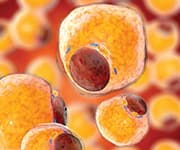Life Extension Magazine®
AMPK is a cell enzyme that turns on fat-burning1 and other beneficial cellular processes.2,3
With age, AMPK activity tends to decrease.4
Two plant compounds have been shown to promote youthful AMPK activity:5,6
- Gynostemma pentaphyllum5,7 and
- Hesperidin.8
Together, these compounds may help slash unwanted belly fat.
What is AMPK?
Excess abdominal fat is a major health problem.
It churns out a steady stream of pro-inflammatory compounds that damage blood vessels, heart muscle, brain cells, and other tissues.9,10
Belly fat is strongly linked to heart disease,10,11 type II diabetes,12 and other health issues.13,14
AMPK is an enzyme inside cells that helps regulate glucose and fat metabolism.15-17
When activated, AMPK enhances energy metabolism,2,18 which helps reduce abdominal fat5 and the inflammation18 it produces.
AMPK signaling may decline with age. This results in impaired metabolic function, increased inflammation, and reduced cellular housekeeping functions—all of which accelerate aging.2,18,19
A decrease in AMPK activity also leads to weight gain because the body is more likely to store fat rather than burn it for energy.20
The plant compounds G. pentaphyllum and hesperidin have been shown to promote AMPK activity, mitigating abdominal obesity and the damaging inflammation it generates.
Enhanced Gynostemma
Gynostemma pentaphyllum is an herb that has been shown in clinical and preclinical studies to help prevent metabolic disorders like obesity,21 glucose metabolism,7 elevated lipid levels,7,22 and fatty liver.21-24
Lab and animal studies also demonstrate that G. pentaphyllum is an AMPK activator7,23 that stimulates fat burning and cellular uptake of glucose in muscle cells. It has been shown to decrease weight gain and cholesterol levels.22,23
In a 2022 mouse study, researchers found that Gynostemma extract inhibited weight gain.25
In another study, G. pentaphyllum extract reduced fat mass, enhanced exercise endurance, and increased performance in treadmill-trained mice.26
To fully combat the age-related drop-off in AMPK activity in humans and the resultant belly fat accumulation, researchers in South Korea developed a much stronger form of this extract than was initially available at the time.
They used heat and pressure treatments combined with a steam sterilization technique called autoclaving to produce a G. pentaphyllum extract that contains 10 times the quantity of two of its key AMPK-boosting compounds, damulin A and damulin B.27 This specially processed G. pentaphyllum has been the gold standard for several years.
In a 12-week human trial, this extract triggered a remarkable 11% decrease in abdominal fat.5
This potent G. pentaphyllum extract is so novel, it was granted a patent by the U.S. government.27
Losing Belly and Body Fat
To validate this extract’s ability to reduce abdominal obesity, scientists enlisted 80 overweight people with a body mass index (BMI) between 25 and 30 kg/m2.
Volunteers were randomly assigned to receive 450 mg a day of the patented G. pentaphyllum extract or a placebo. Both groups continued their usual diets.
During the 12-week study, total abdominal fat area, body weight, body fat mass, percent body fat, and body mass index all decreased in those taking G. pentaphyllum compared to placebo recipients.5
The results showed that:5
- Total fat area fell 6.3% in people receiving extracts, but less than 1% in the placebo group,
- Abdominal fat deposits fell 11% in the extract group, but only 3% in the placebo group, and
- Subcutaneous fat (found just under the skin) decreased nearly 4% in treated subjects, but increased slightly in placebo recipients.
Additionally, those receiving G. pentaphyllum lost an average of one inch off their waistline, equal to about one belt notch.
What you need to know
Get Help Burning Belly Fat
- Activity of the “fat-burning enzyme” AMPK can decrease with age, contributing to accumulation of dangerous and inflammatory abdominal fat.
- Researchers developed an extract of Gynostemma pentaphyllum that contains 10 times the usual amount of two AMPK-activating compounds.
- This patented G. pentaphyllum extract was shown in a controlled human study to reduce total fat area by 6.3% and abdominal fat deposits by 11%.
- The citrus flavonoid hesperidin also boosts AMPK and was shown in a human trial to reduce percent of body fat by 3.7%.
- G. pentaphyllum and hesperidin can be taken together to help activate AMPK and reduce abdominal fat and its deadly effects.
Fat-Fighting Hesperidin
Hesperidin is a flavonoid found in citrus fruits. Preclinical studies have demonstrated that it activates AMPK.6,8,28,29
It may help fight fat accumulation in other ways as well, including by:
- Inhibiting absorption of dietary fat from the gut,30,31
- Inhibiting genes involved in all phases of fat cell development,32
- Promoting the production of enzymes that break down body fat,32,33
- Reducing body fat accumulation and storage,32 and
- Increasing secretion of adiponectin, a hormone that decreases appetite and inflammation.8
In a human study, 40 healthy amateur athletes were given 500 mg of hesperidin or a placebo daily for eight weeks. They maintained their usual diet and lifestyle.34
In the hesperidin group, average percent body fat decreased by 3.7%.34
In a clinical trial of 24 individuals with metabolic syndrome, participants were given 500 mg per day of hesperidin or placebo for three weeks. After three weeks significant improvements in biomarkers of inflammation, vascular function and metabolic parameters were seen in the treatment group compared to placebo.6
Together, hesperidin and Gynostemma extract may complement each other and maximize the effect of targeting abdominal fat.
Summary
The decline in AMPK activity that occurs with aging leads to increased abdominal fat and harmful inflammation.
Gynostemma pentaphyllum extract increases AMPK activity and reduces belly fat.
Preclinical evidence has revealed that the citrus compound hesperidin also stimulates AMPK activity and could work in other ways to further reduce belly and overall body fat.
These compounds provide a dual-action approach to reducing abdominal fat. •
If you have any questions on the scientific content of this article, please call a Life Extension Wellness Specialist at 1-866-864-3027.
References
- Wang Q, Sun J, Liu M, et al. The New Role of AMP-Activated Protein Kinase
in Regulating Fat Metabolism and Energy Expenditure
in Adipose Tissue. Biomolecules. 2021 Nov 24;11(12). - Salminen A, Kaarniranta K. AMP-activated protein kinase (AMPK) controls the
aging process via an integrated signaling network.
Ageing Res Rev. 2012 Apr;11(2):230-41. - Tamargo-Gomez I, Marino G. AMPK: Regulation of Metabolic Dynamics in the Context of Autophagy. Int J Mol Sci. 2018 Nov 29;19(12).
- Salminen A, Ojala J, Kaarniranta K, et al. Mitochondrial dysfunction and oxidative stress activate inflammasomes: impact on the aging process and age-related diseases. Cell Mol Life Sci. 2012 Sep;69(18):2999-3013.
- Park SH, Huh TL, Kim SY, et al. Antiobesity effect of Gynostemma pentaphyllum extract (actiponin): a randomized, double-blind, placebo-controlled trial. Obesity (Silver Spring). 2014 Jan;22(1): 63-71.
- Rizza S, Muniyappa R, Iantorno M, et al. Citrus polyphenol hesperidin stimulates production of nitric oxide in endothelial cells while improving endothelial function and reducing inflammatory markers in patients with metabolic syndrome. J Clin Endocrinol Metab. 2011 May;96(5):E782-92.
- Nguyen PH, Gauhar R, Hwang SL, et al. New dammarane-type glucosides as potential activators of AMP-activated protein kinase (AMPK) from Gynostemma pentaphyllum. Bioorg Med Chem. 2011 Nov 1;19(21):6254-60.
- Xiong H, Wang J, Ran Q, et al. Hesperidin: A Therapeutic Agent For Obesity. Drug Des Devel Ther. 2019;13:3855-66.
- Bawadi H, Katkhouda R, Tayyem R, et al. Abdominal Fat Is Directly Associated With Inflammation In Persons With Type-2 Diabetes Regardless Of Glycemic Control - A Jordanian Study. Diabetes Metab Syndr Obes. 2019;12:2411-7.
- Powell-Wiley TM, Poirier P, Burke LE, et al. Obesity and Cardiovascular Disease: A Scientific Statement From the American Heart Association. Circulation. 2021 May 25;143(21):e984-e1010.
- Lee JJ, Pedley A, Hoffmann U, et al. Association of Changes in Abdominal Fat Quantity and Quality With Incident Cardiovascular Disease Risk Factors. J Am Coll Cardiol. 2016 Oct 4;68(14): 1509-21.
- Freemantle N, Holmes J, Hockey A, et al. How strong is the association between abdominal obesity and the incidence of type 2 diabetes? Int J Clin Pract. 2008 Sep;62(9):1391-6.
- Shuster A, Patlas M, Pinthus JH, et al. The clinical importance of visceral adiposity: a critical review of methods for visceral adipose tissue analysis. Br J Radiol. 2012 Jan;85(1009):1-10.
- Tchernof A, Despres JP. Pathophysiology of human visceral obesity: an update. Physiol Rev. 2013 Jan;93(1):359-404.
- Long YC, Zierath JR. AMP-activated protein kinase signaling in metabolic regulation. J Clin Invest. 2006 Jul;116(7):1776-83.
- McCarty MF. AMPK activation--protean potential for boosting healthspan. Age (Dordr). 2014 Apr;36(2):641-63.
- Srivastava RA, Pinkosky SL, Filippov S, et al. AMP-activated protein kinase: an emerging drug target to regulate imbalances in lipid and carbohydrate metabolism to treat cardio-metabolic diseases. J Lipid Res. 2012 Dec;53(12):2490-514.
- Salminen A, Hyttinen JM, Kaarniranta K. AMP-activated protein kinase inhibits NF-kappaB signaling and inflammation: impact on healthspan and lifespan. J Mol Med (Berl). 2011 Jul;89(7):667-76.
- Salminen A, Kaarniranta K, Kauppinen A. Age-related changes in AMPK activation: Role for AMPK phosphatases and inhibitory phosphorylation by upstream signaling pathways. Ageing Res Rev. 2016 Jul;28:15-26.
- Kola B. Role of AMP-activated protein kinase in the control of appetite. J Neuroendocrinol. 2008 Jul;20(7):942-51.
- Nguyen NH, Ha TKQ, Yang JL, et al. Triterpenoids from the genus Gynostemma: Chemistry and pharmacological activities. J Ethnopharmacol. 2021 Mar 25;268:113574.
- Wang M, Wang F, Wang Y, et al. Metabonomics study of the therapeutic mechanism of Gynostemma pentaphyllum and atorvastatin for hyperlipidemia in rats. PLoS One. 2013;8(11):e78731.
- Gauhar R, Hwang SL, Jeong SS, et al. Heat-processed Gynostemma pentaphyllum extract improves obesity in ob/ob mice by activating AMP-activated protein kinase. Biotechnol Lett. 2012 Sep;34(9):1607-16.
- Tan Y, Kamal MA, Wang ZZ, et al. Chinese herbal extracts (SK0506) as a potential candidate for the therapy of the metabolic syndrome. Clin Sci (Lond). 2011 Apr;120(7):297-305.
- Li S, Wang Y, Dun W, et al. Effect of Polysaccharide Extracted From Gynostemma Pentaphyllum on the Body Weight and Gut Microbiota of Mice. Front Nutr. 2022;9:916425.
- Kim YH, Jung JI, Jeon YE, et al. Gynostemma pentaphyllum extract and its active component gypenoside L improve the exercise performance of treadmill-trained mice. Nutr Res Pract. 2022 Jun;16(3):298-313.
- Available at: https://patents.google.com/patent/US8357786B2/en. Accessed March, 7, 2023.
- Pu P. [Protection mechanisms of hesperidin on mouse with insulin resistance]. Zhongguo Zhong Yao Za Zhi. 2016 Sep;41(17):3290-5.
- Day EA, Ford RJ, Steinberg GR. AMPK as a Therapeutic Target for Treating Metabolic Diseases. Trends Endocrinol Metab. 2017 Aug;28(8):545-60.
- Yun JW. Possible anti-obesity therapeutics from nature--a review. Phytochemistry. 2010 Oct;71(14-15):1625-41.
- Huang R, Zhang Y, Shen S, et al. Antioxidant and pancreatic lipase inhibitory effects of flavonoids from different citrus peel extracts: An in vitro study. Food Chem. 2020 Oct 1;326:126785.
- Gomez-Zorita S, Lasa A, Abendano N, et al. Phenolic compounds apigenin, hesperidin and kaempferol reduce in vitro lipid accumulation in human adipocytes. J Transl Med. 2017 Nov 21;15(1):237.
- Rufino AT, Costa VM, Carvalho F, et al. Flavonoids as antiobesity agents: A review. Med Res Rev. 2021 Jan;41(1):556-85.
- Martinez Noguera FJ, Alcaraz PE, Carlos Vivas J, et al. 8 weeks of 2S-Hesperidin supplementation improves muscle mass and reduces fat in amateur competitive cyclists: randomized controlled trial. Food Funct. 2021 May 11;12(9):3872-82.



